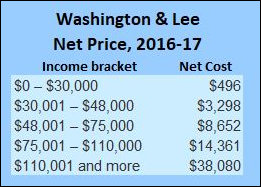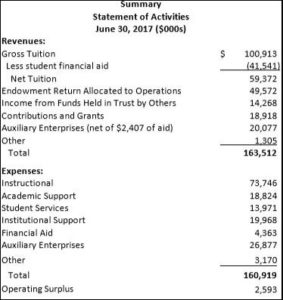Washington & Lee University is the latest in a growing line of higher-ed institutions to engage in navel gazing and self-flagellation over its historical role in slavery and racial oppression. While honesty and candor in such matters is always called for — it is all too easy to sweep uncomfortable legacies under the rug — W&L’s priorities are largely misplaced. W&L, like other elite institutions, should be examining the role it plays in perpetuating elitism and tax-exempt privilege today. Of course, that would require asking truly uncomfortable questions for the people who benefit from institutional arrangements now, not those who ran the university a century ago.
The Washington Post’s higher-ed writer Susan Svrluga writes today of how President William Dudley has convened a group to “lead us on an examination of how our history — and the ways that we teach, discuss, and represent it — shapes our community.”
The matter is an especially delicate one when the “Lee” in Washington & Lee was none other than Robert E. Lee, who is buried with his family on the campus. Dudley must pursue a delicate balancing act placating both progressive activists in the faculty and student body, who revile Lee and his association with slavery and the Confederacy, and conservative alumni, who revere the general and university president for his personal integrity and role in knitting together a war-torn nation.
The unremitting focus on the past, which is paralleled by similar initiatives at the University of Virginia and other universities, serves the function of distracting attention from how higher education has become a bastion of liberal-progressive privilege today. Indeed, one suspects, that’s the entire point.
Tuition and fees at W&L was $50,170 for the 2017-18 school year — a 10% increase from three years previously. (For point of reference, the Consumer Price Index increased 3.7% over that period.) Room, board and other expenses, which decreased slightly, brought the total to $65,950, according to College Navigator.
Admittedly, that’s the sticker price, and only the wealthiest families pay the full freight. W&L discounts heavily depending on financial need, providing grants and financial aid to 57% of the student body. Here are the figures for average net price by income bracket in 2016-17:
 College Navigator calculates average net price by subtracting the average amount of federal, state/local government, or institutional grant or scholarship aid from the total cost of attendance. While W&L does discount tuition for members of the middle class, the net price — $38,000 — is still extremely high for two-income, middle-class families making middle-class salaries amounting to more than $110,000 a year.
College Navigator calculates average net price by subtracting the average amount of federal, state/local government, or institutional grant or scholarship aid from the total cost of attendance. While W&L does discount tuition for members of the middle class, the net price — $38,000 — is still extremely high for two-income, middle-class families making middle-class salaries amounting to more than $110,000 a year.
While higher-ed institutions like to emphasize that the net price is much lower than the listed price, over the past two years at W&L, the net price increased even more rapidly than the sticker price. Between 2014-15 and 2016-17, the net price increased 17% to $25,029. Unlike Virginia’s public universities, W&L cannot blame cuts in state support for the soaring cost of attendance.
 W&L financial statements make a point of informing readers that the tuition charged does not cover the full cost of educating its students. In the 2016-17 school year, that cost was put at $63,000 per student. The previous year, the implicit subsidy was calculated to be slightly more than $13,400 per student per year. That balance was made up largely through the tax-deductible donations of alumni — $22.7 million in 2015-16 — and revenues from W&L’s tax-exempt endowment.
W&L financial statements make a point of informing readers that the tuition charged does not cover the full cost of educating its students. In the 2016-17 school year, that cost was put at $63,000 per student. The previous year, the implicit subsidy was calculated to be slightly more than $13,400 per student per year. That balance was made up largely through the tax-deductible donations of alumni — $22.7 million in 2015-16 — and revenues from W&L’s tax-exempt endowment.
A couple of points are worth making here. First, a $63,000 cost per student sounds extraordinarily high. It may be peanuts compared to the tax-free sums lavished upon the students at elite Ivy League schools, but it is mind-boggling by any other measure. I can’t begin to imagine what kind of costs are baked into that figure, and the financial statements don’t tell us. W&L is not a research university, so there aren’t any hidden subsidies for laboratories, graduate students and super-star research faculty. Perhaps the faculty-student ratio is really low, and students benefit from small class sizes. Perhaps W&L has extravagant administrative overhead. It would be interesting to know.
Second, despite generous financial aid provided for lower-income students, the student body still is overwhelmingly affluent. College Navigator does not provide student household-income data, but it does provide a proxy — average SAT scores, which is closely correlated with income. The average SAT scores for reading and writing are 680 (25th percentile) and 740 (75th percentile). That’s high –a hair higher than the University of Virginia.
Even though W&L adopts an income-redistribution tuition model that sticks it to the middle class, the institution benefits from lavish tax breaks that benefit both an affluent student body and left-leaning professors and administrators. (I don’t know if W&L’s faculty and administrators are more liberal/leftist in their views and teaching than their peers at other institutions, but I feel safe in saying that they are more liberal/leftist than the tax-paying population as a whole.)
As a tax-exempt nonprofit, W&L pays no property taxes, sales taxes, BPOL taxes, machine-and-tool taxes, sales taxes, or corporate income taxes. It’s income (referred to as an “operating surplus”) is nominal, but the other tax breaks are significant. Meanwhile, W&L alumni enjoy tax deductions for the $20 million or so they donate every year to subsidize students’ tuition. And the $1.5 billion W&L endowment, which in 2016-17 had reported an 11.4% compounded rate of return over 10 years, is non-taxable.
I haven’t decided whether the biggest beneficiaries of the system are the privileged students who attend W&L or the privileged employees of an institution that relentlessly increases tuition & fees, benefits from taxpayer subsidies, and obsesses over the historical sins of their forebears. Either way, the question should stimulate a good discussion. And either way, it’s a discussion that we are less likely to have while fixating on century-old issues like slavery and Jim Crow.



